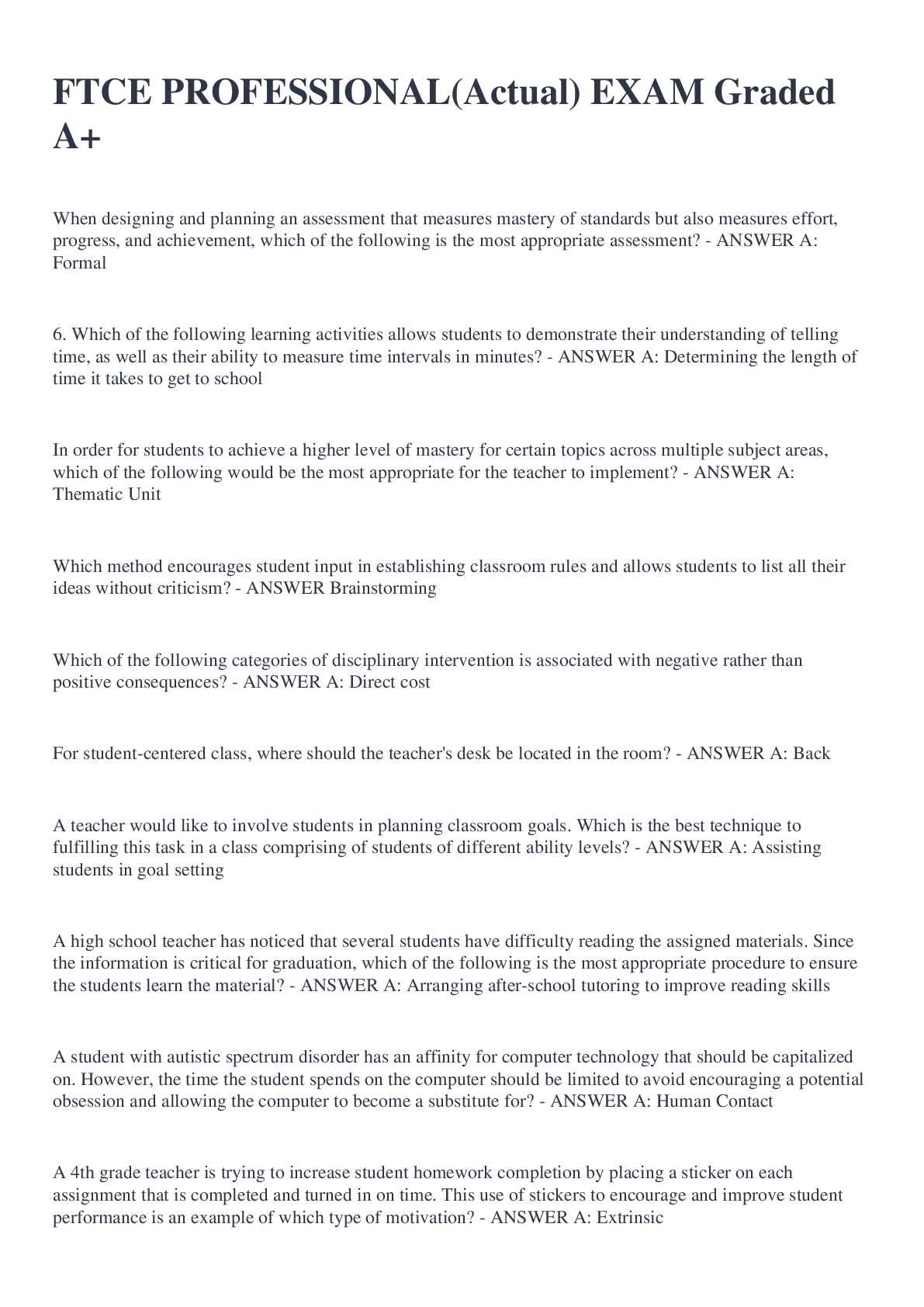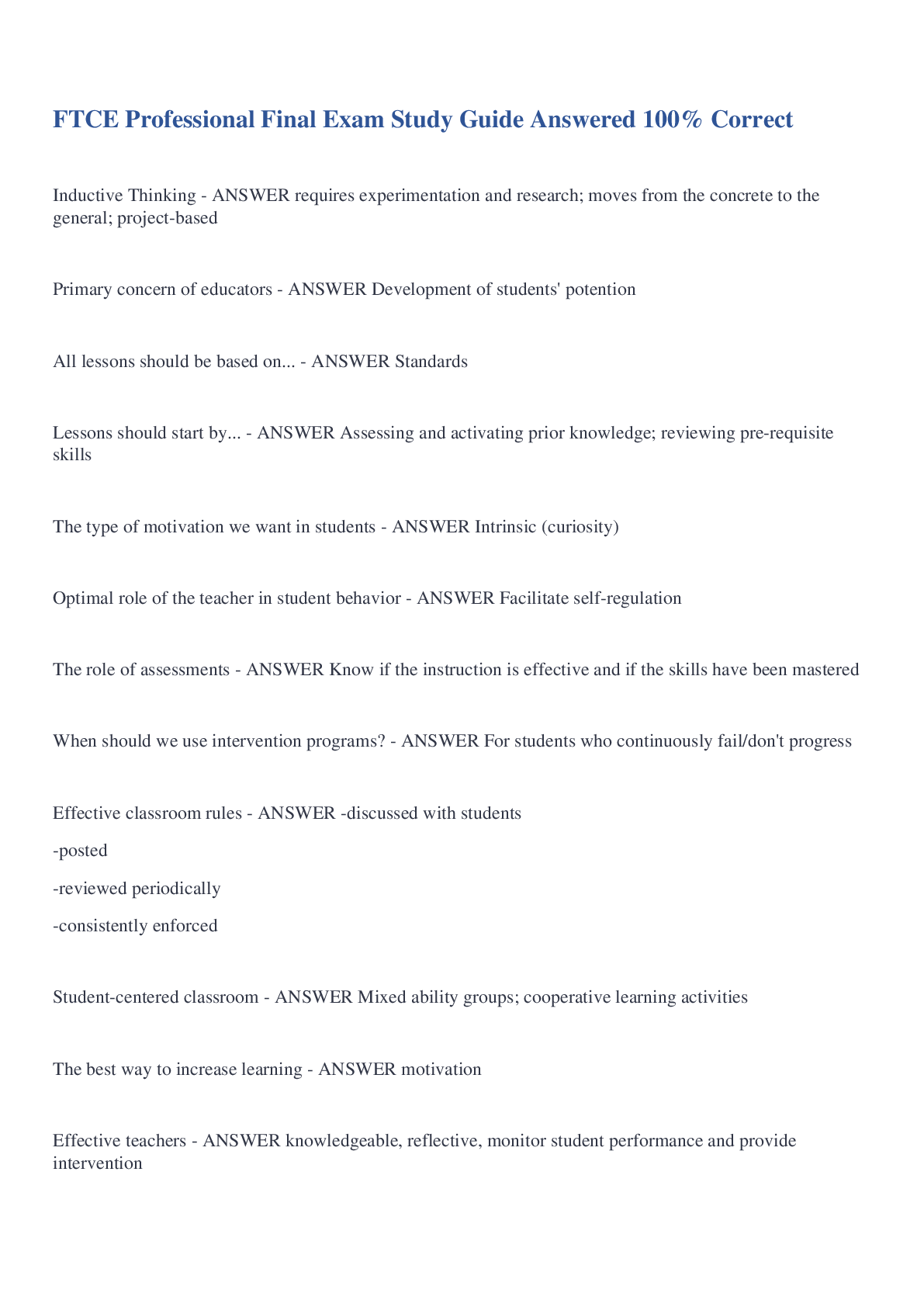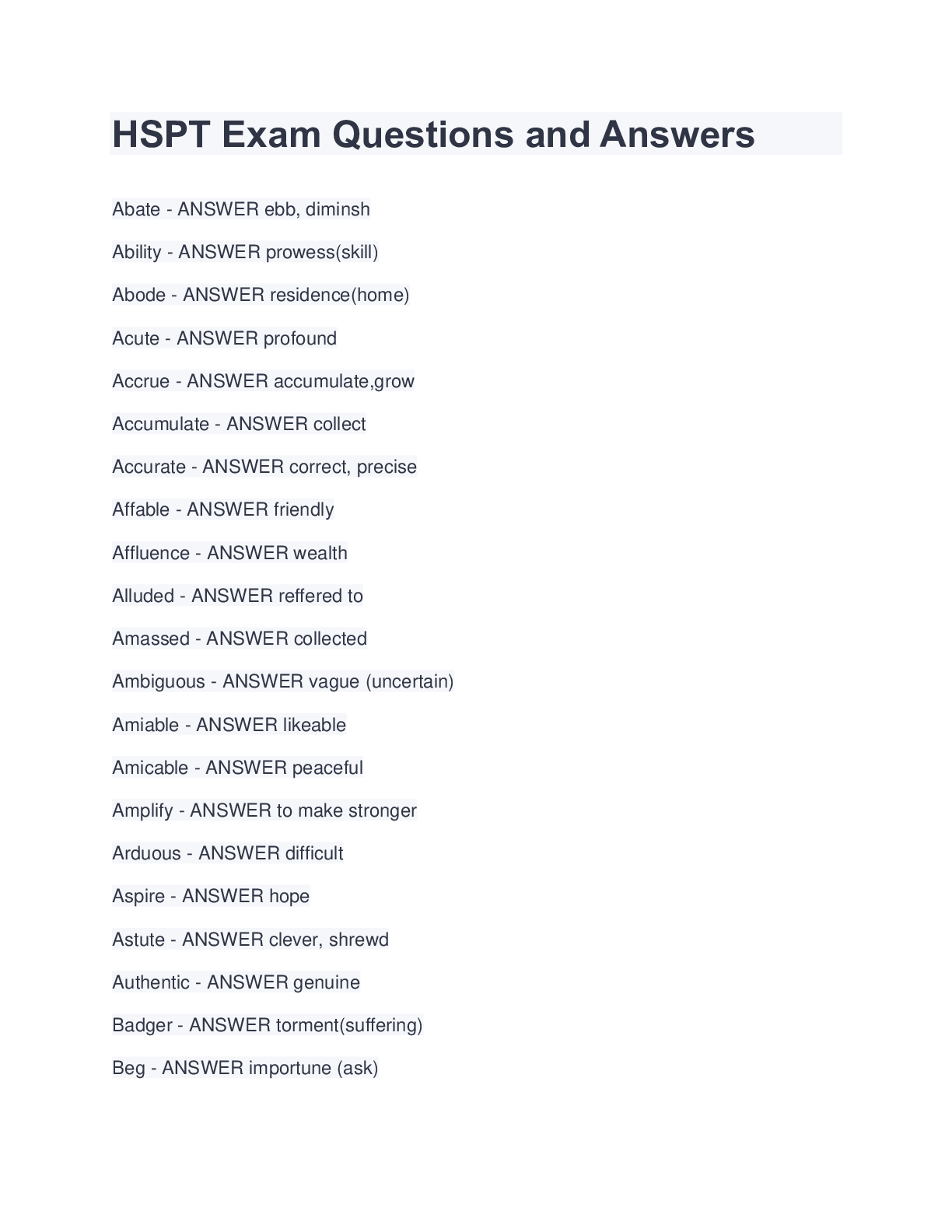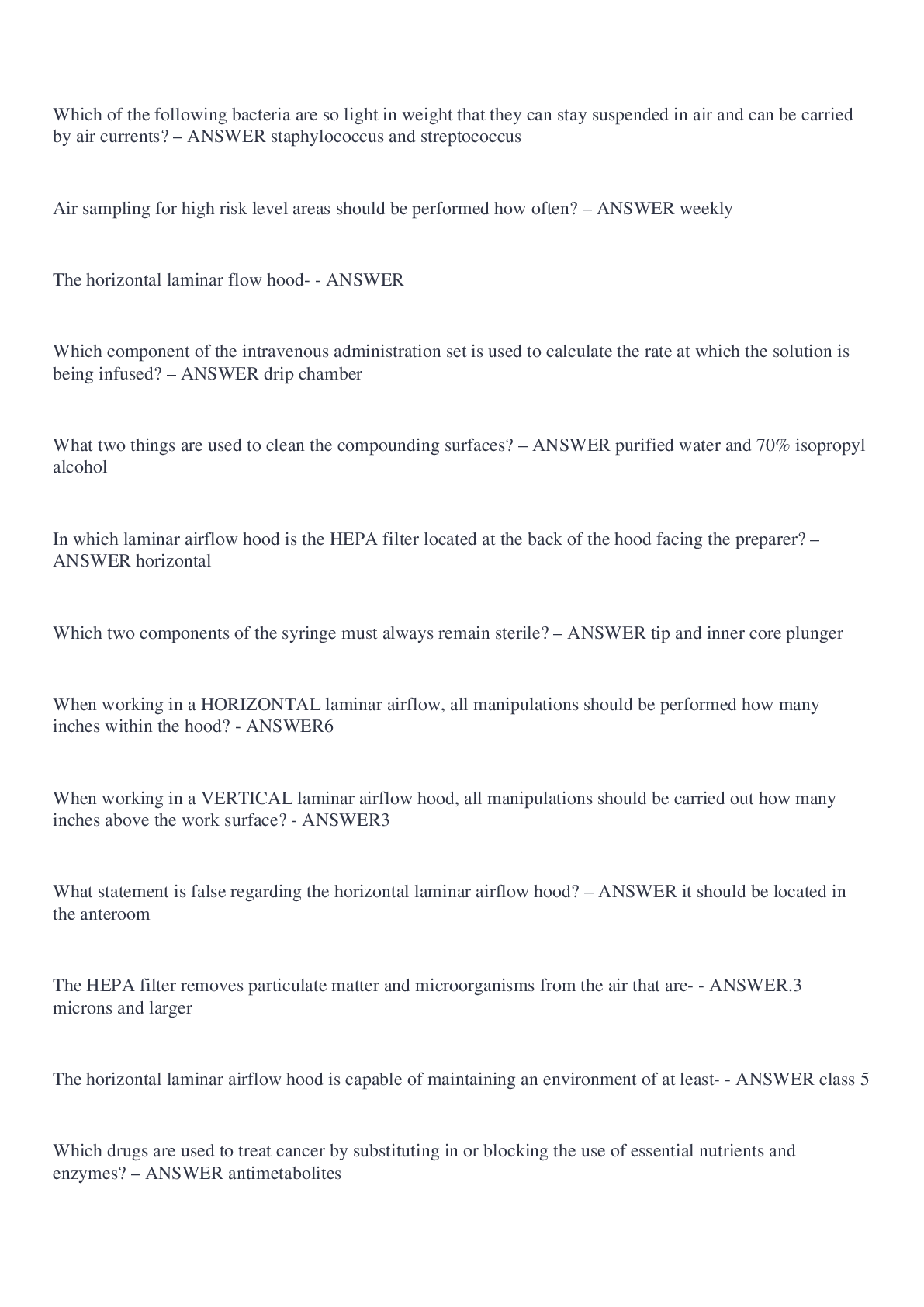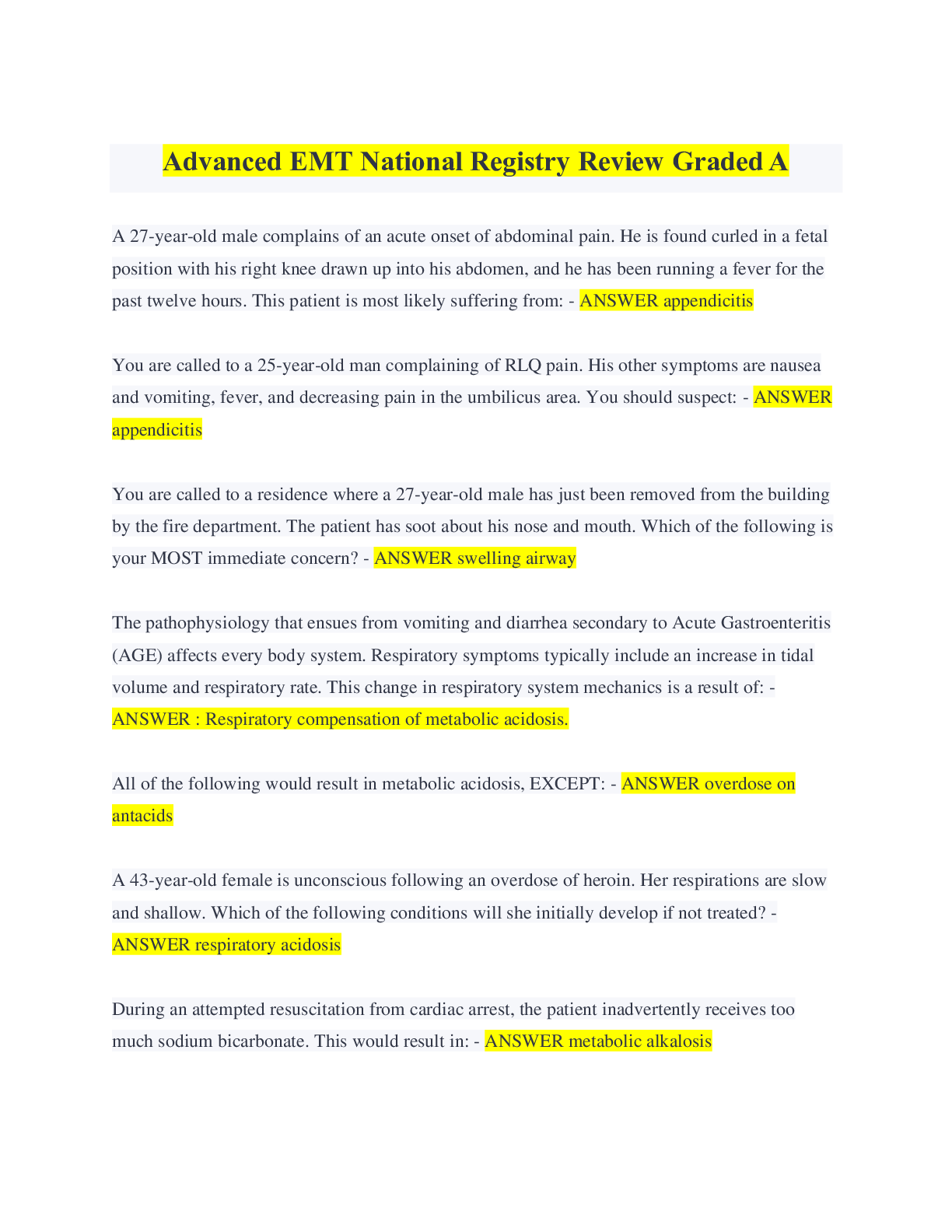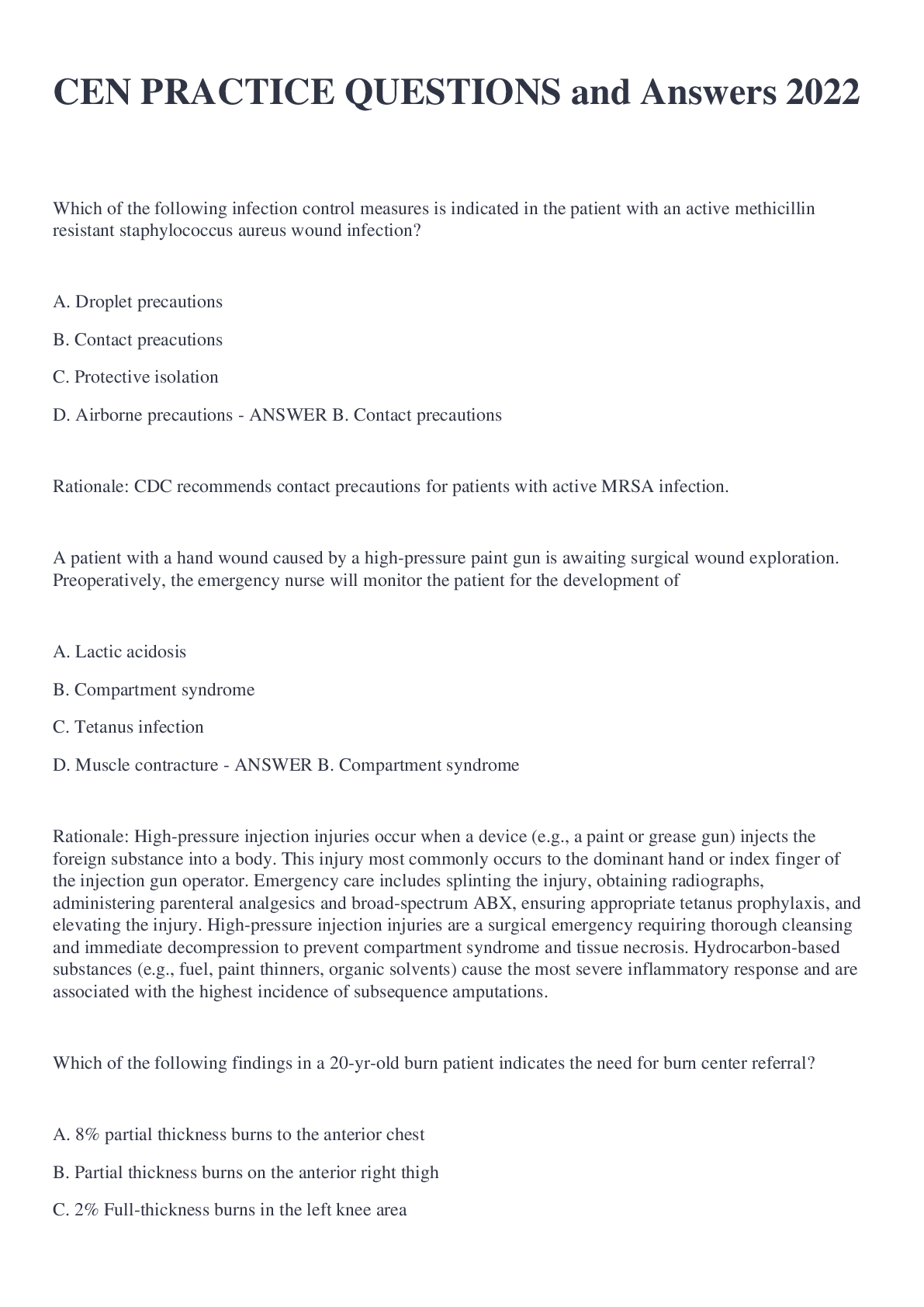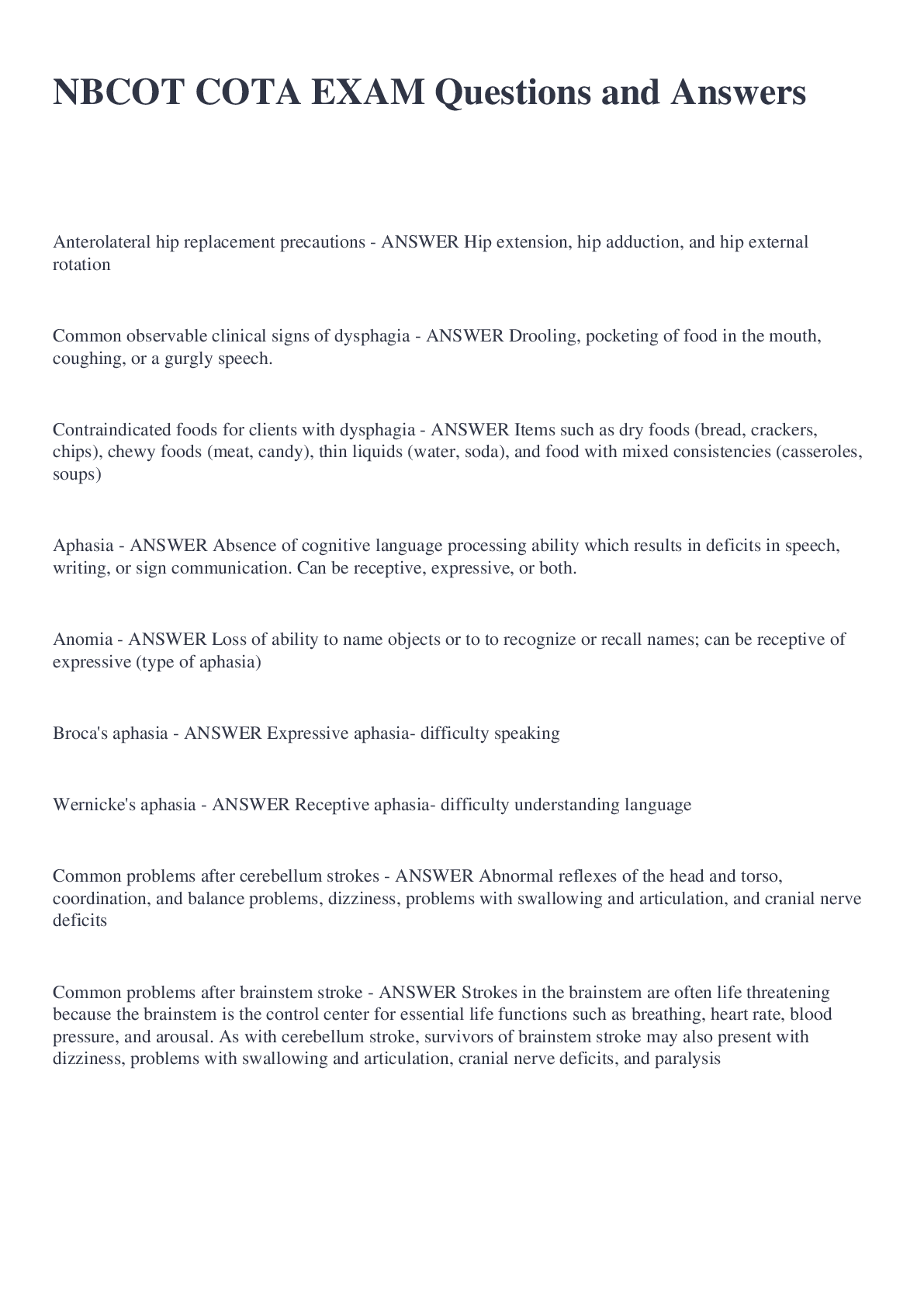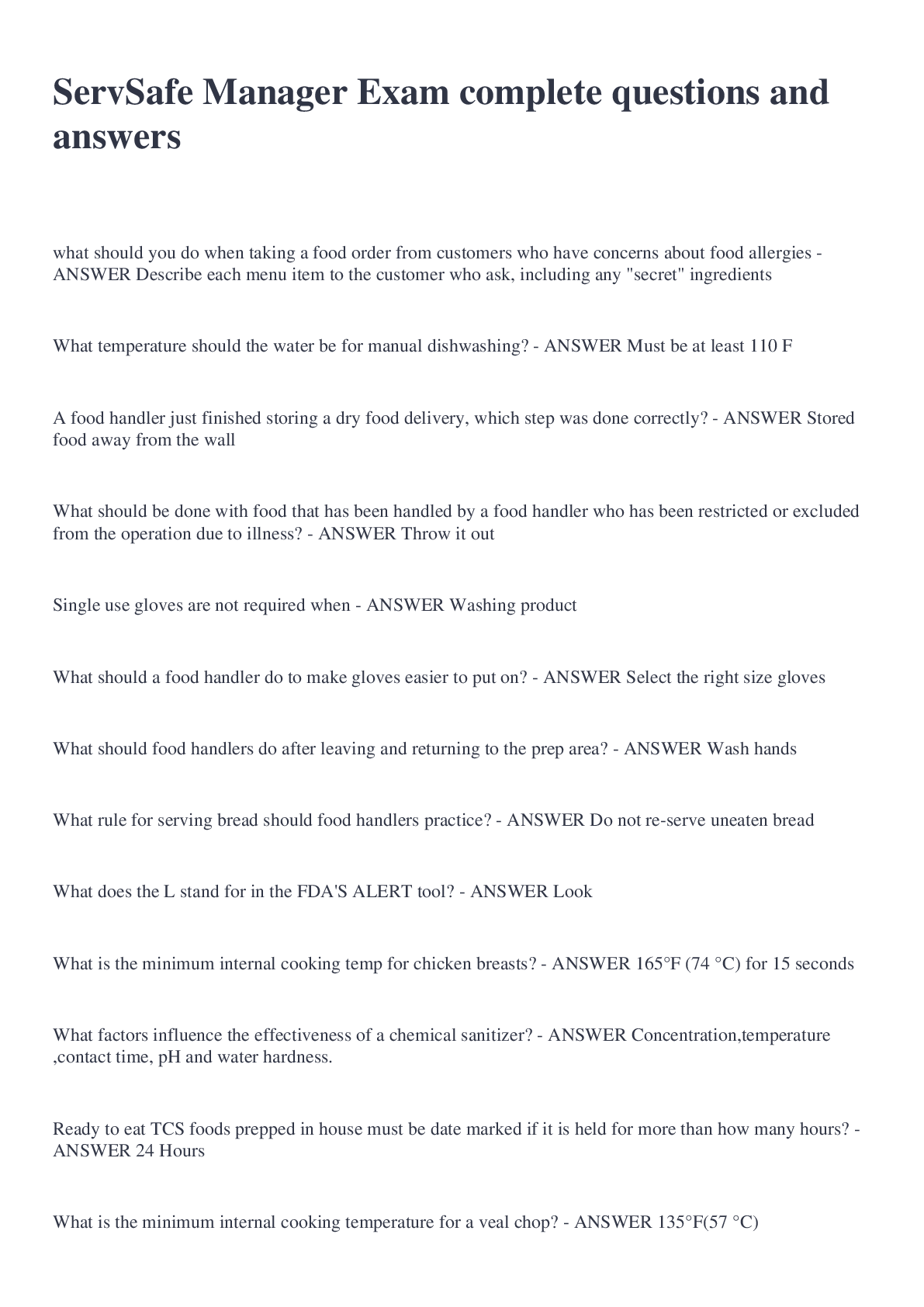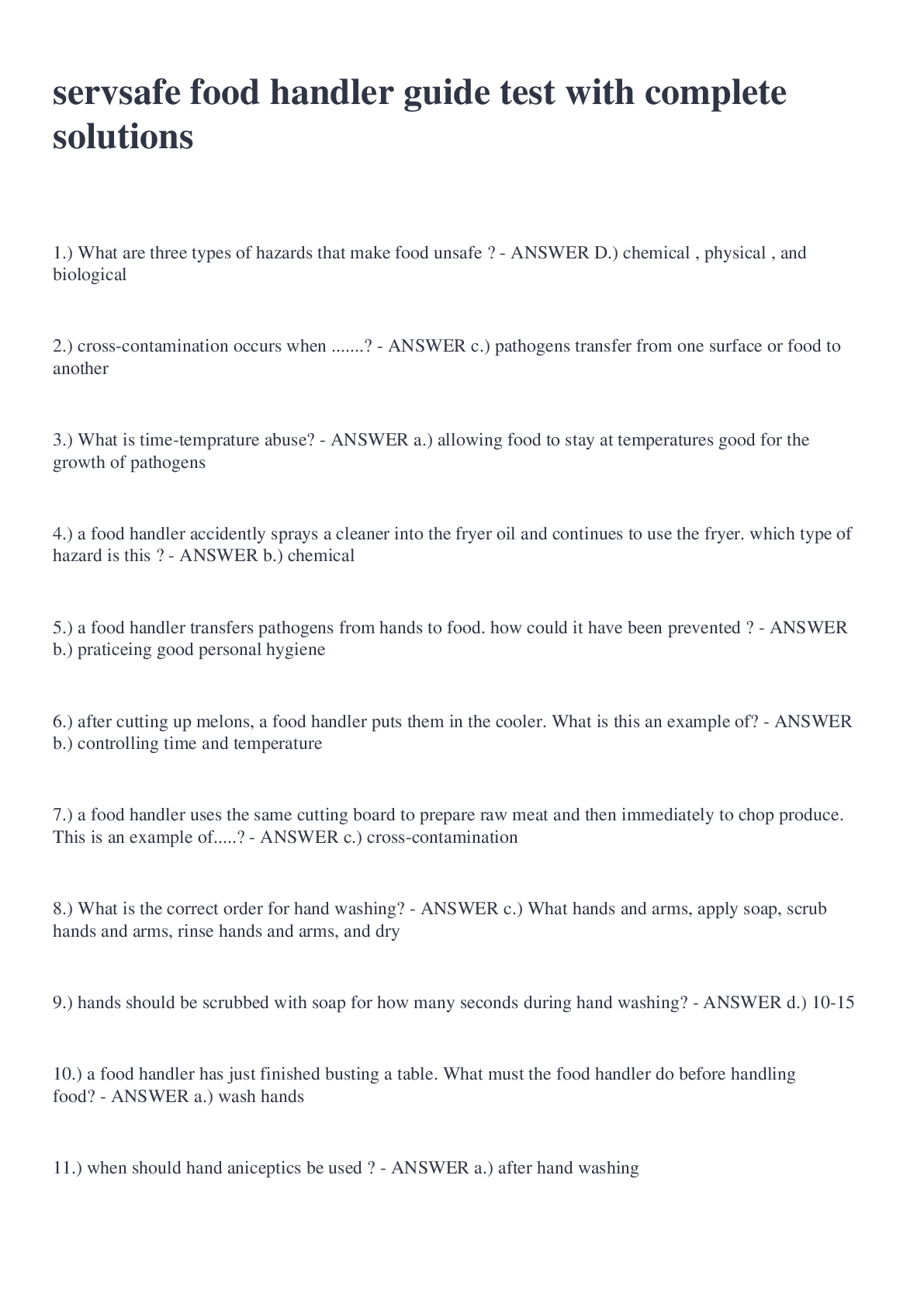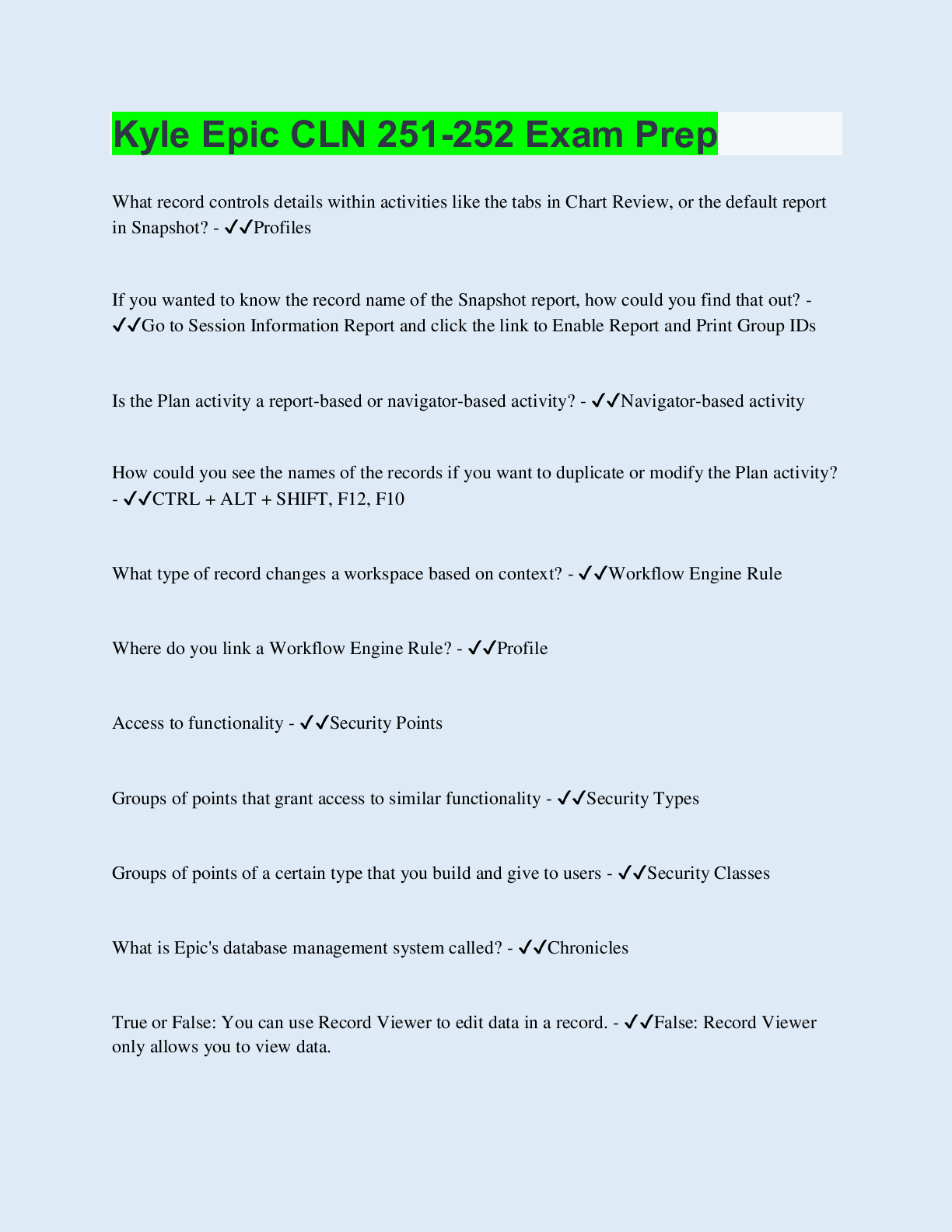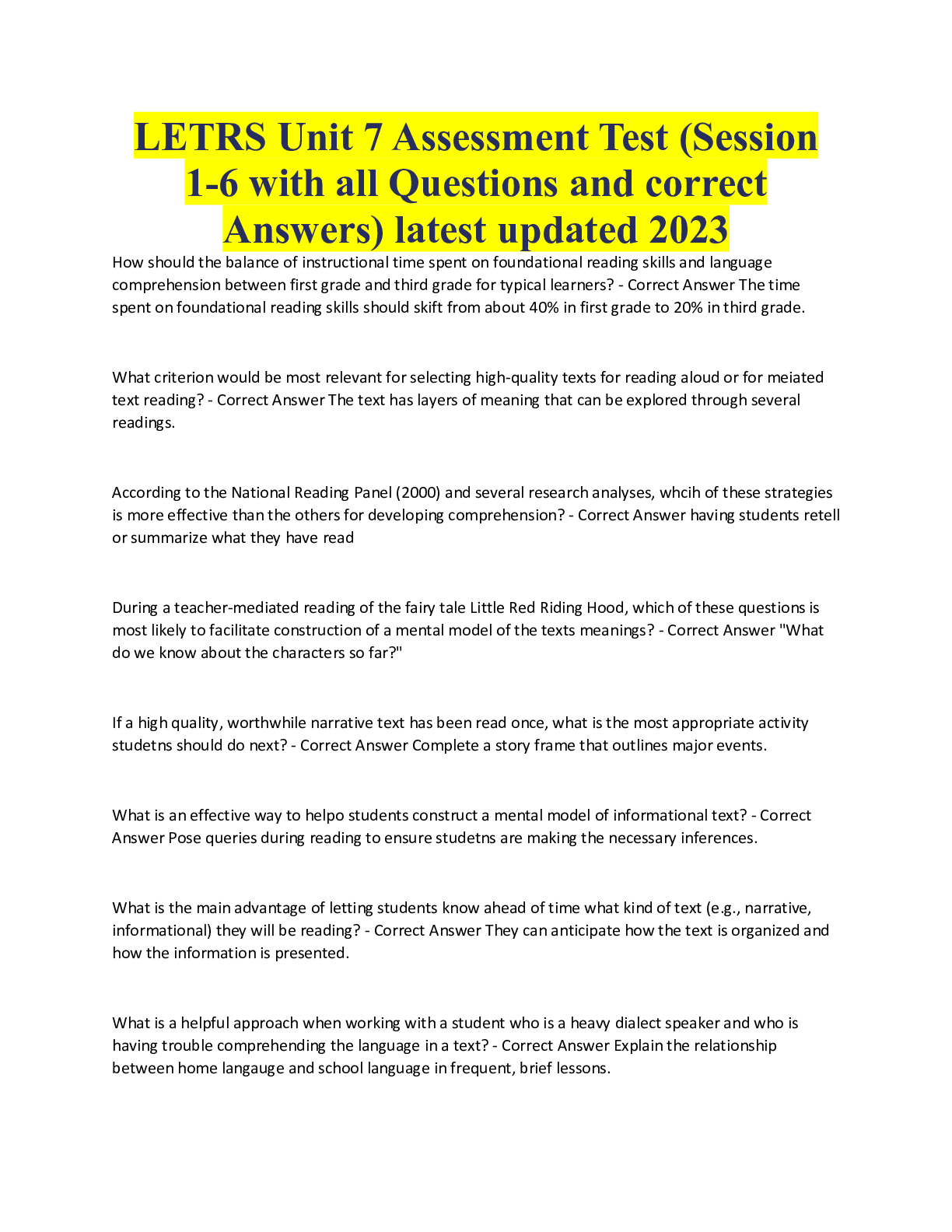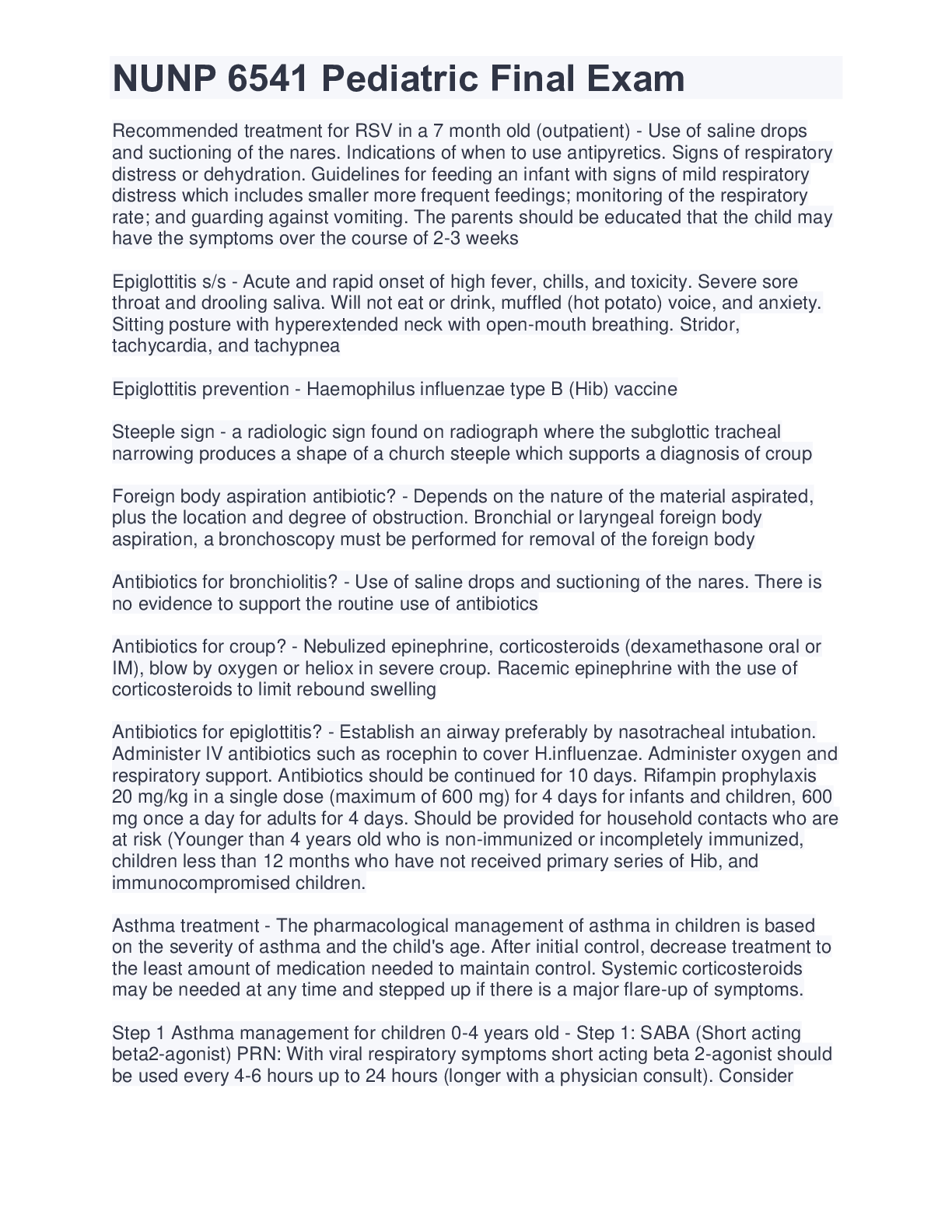Health Care > EXAM > NUNP 6541 Pediatric Final Exam-Walden U 2022 (All)
NUNP 6541 Pediatric Final Exam-Walden U 2022
Document Content and Description Below
Recommended treatment for RSV in a 7-month-old (outpatient) - ANSWER Use of saline drops and suctioning of the nares. Indications of when to use antipyretics. Signs of respiratory distress or dehydrat... ion. Guidelines for feeding an infant with signs of mild respiratory distress which includes smaller more frequent feedings; monitoring of the respiratory rate; and guarding against vomiting. The parents should be educated that the child may have the symptoms over the course of 2-3 weeks Epiglottitis s/s - ANSWER Acute and rapid onset of high fever, chills, and toxicity. Severe sore throat and drooling saliva. Will not eat or drink, muffled (hot potato) voice, and anxiety. Sitting posture with hyperextended neck with open-mouth breathing. Stridor, tachycardia, and tachypnea Epiglottitis prevention - ANSWER Hemophilus influenzae type B (Hib) vaccine Steeple sign - ANSWER a radiologic sign found on radiograph where the subglottic tracheal narrowing produces a shape of a church steeple which supports a diagnosis of croup Foreign body aspiration antibiotic? - ANSWER Depends on the nature of the material aspirated, plus the location and degree of obstruction. Bronchial or laryngeal foreign body aspiration, a bronchoscopy must be performed for removal of the foreign body Antibiotics for bronchiolitis? - ANSWER Use of saline drops and suctioning of the nares. There is no evidence to support the routine use of antibiotics Antibiotics for croup? - ANSWER Nebulized epinephrine, corticosteroids (dexamethasone oral or IM), blow by oxygen or heliox in severe croup. Racemic epinephrine with the use of corticosteroids to limit rebound swelling Antibiotics for epiglottitis? - ANSWER Establish an airway preferably by nasotracheal intubation. Administer IV antibiotics such as rocephin to cover H.influenzae. Administer oxygen and respiratory support. Antibiotics should be continued for 10 days. Rifampin prophylaxis 20 mg/kg in a single dose (maximum of 600 mg) for 4 days for infants and children, 600 mg once a day for adults for 4 days. Should be provided for household contacts who are at risk (Younger than 4 years old who is non-immunized or incompletely immunized, children less than 12 months who have not received primary series of Hib, and immunocompromised children. Asthma treatment - ANSWER The pharmacological management of asthma in children is based on the severity of asthma and the child's age. After initial control, decrease treatment to the least amount of medication needed to maintain control. Systemic corticosteroids may be needed at any time and stepped up if there is a major flare-up of symptoms. Step 1 Asthma management for children 0-4 years old - ANSWER Step 1: SABA (Short acting beta2-agonist) PRN: With viral respiratory symptoms short acting beta 2-agonist should be used every 4-6 hours up to 24 hours (longer with a physician consult). Consider short course of oral systemic corticosteroids if severe exacerbation. Frequent use of SABA may indicate the need to step up treatment Step 2 Asthma management for children 0-4 years old - ANSWER Step 2: Consider consultation with asthma specialist. Low dose of inhaled corticosteroids. Step 3 asthma mgmt for children 0-4 yrs - ANSWER Step 3: Medium-dose of inhaled corticosteroids Steps 4-6 asthma mgmt for children 0-4 yrs - ANSWER Step 4: Medium-dose ICS and Long acting beta2-agonist or montelukast. Step 5: High dose ICS and Long acting beta 2-agonist or montelukast. Step 6: High dose of ICS and LABA or montelukast and oral corticosteroids Steps 1-3 asthma mgmt for children 5-11 yrs - ANSWER Step 1: SABA (Short acting beta 2-agonist) PRN: Increasing the use of short-acting beta 2-agonist or use greater than 2 days a week for symptom relief generally indicates inadequate control and the need to step up treatment. Step 2: Consider consultation with asthma specialist. Low dose of inhaled corticosteroids. Step 3: Low dose of inhaled corticosteroid and LABA. Or medium dose of inhaled corticosteroids. Steps 4-6 asthma mgmt for children 5-11 yrs - ANSWER Step 4: Medium-dose ICS and LABA or medium dose of inhaled corticosteroid and leukotriene receptor antagonist or theophylline. . Step 5: High dose ICS and LABA or high dose of inhaled corticosteroid and leukotriene receptor antagonist or theophylline. . Step 6: High dose of ICS and LABA and oral corticosteroids or high dose of inhaled corticosteroids and leukotriene receptor antagonist or theophylline and oral corticosteroids. ** Theophylline levels must be monitored. Differentials for patient with sore throat - ANSWER Strep pharyngitis Peritonsillar abscess Viral pharyngitis Infectious mononucleosis Epiglottitis small-for-gestational-age infants: which type of chromosomal analysis should be included? - ANSWER Trisomy 18 Holt-Olram Trisomy 13 Turner Syndrome Trisomy 21 Prader-Willi Syndrome heart defects associated with Down syndrome - ANSWER Atrioventricular Septal Defect Ventricular Septal Defect Persistant Ductus Arteriosus Tetrology of Fallot Contact sports with Down's Syndrome - ANSWER Do not recommend due to atlantoaxial instability Diagnosing Down Syndrome - ANSWER Usually identified at birth by the presence of certain physical traits: low muscle tone, a single deep crease across the palm of the hand, a slightly flattened facial profile and an upward slant to the eyes. Because these features may be present in other babies, a chromosomal analysis called a karyotype is done to confirm the diagnosis. To obtain a karyotype, doctors draw a blood sample to examine the baby's cells. They photograph the chromosomes and then group them by size, number, and shape. By examining the karyotype, doctors can diagnose. Another genetic test called FISH can apply similar principles and confirm a diagnosis in a shorter amount of time Diagnosing Trisomy 18 (Edwards Syndrome) - ANSWER A sample of the baby's dna is extracted from a blood sample or other bodily cells or tissue and is cultured to examine a picture of the chromosomes called a karyotype. In order to get this picture, the chromosomes are isolated, stained, and examined under the microscope. Most often, this is done using the chromosomes in the white blood cells. A picture of the chromosomes is taken through the microscope. A visible extra 18th chromosome confirms a Trisomy 18 diagnosis Diagnosing Holt-Oram Syndrome - ANSWER A diagnosis may be suspected when a person is found to have changes in the way the bones of the wrist and other bones of the upper limb are formed. The diagnosis can be confirmed if a person has specific bone changes and a personal or family history of an atrial septal defect, ventricular septal defect, or cardiac conduction disease. In order to establish the diagnosis, a doctor may order tests including an x-ray of the hands, wrists, and arms, a echocardiogram, and an electrocardiogram. The diagnosis may also be confirmed with genetic testing of the TBX5 gene Diagnosing Trisomy 13 - ANSWER Parents who are at risk to have a translocation due to their family history can have a blood test called a karyotype, which can determine if a translocation is present. Prenatal testing or screening is also available to determine if a current pregnancy is at risk for chromosome disorders. People with a family history who are interested in learning about genetic screening or testing for themselves or family members are encouraged speak with a genetic counselor or other genetics professional. Diagnosing Turner Syndrome - ANSWER A diagnosis may be suspected when there are a number of typical physical features observed such as webbed neck, a broad chest and widely spaced nipples. Sometimes diagnosis is made at birth because of heart problems, an unusually wide neck or swelling of the hands and feet. This can be confirmed by prenatal testing to obtain cells from the unborn baby for chromosomal analysis. If a diagnosis is confirmed prenatally, the baby may be under the care of a specialist pediatrician immediately after birth Diagnosis is confirmed by a blood test, called a karyotype. This is used to analyze the chromosomal composition of the female Fragile X Syndrome (Martin-Bell Syndrome) - ANSWER a genetic condition that causes a range of developmental problems including learning disabilities and cognitive impairment. Usually, males are more severely affected by this disorder than females. Affected individuals usually have delayed development of speech and language by age 2, mild to moderate intellectual disability, about one-third of affected females are intellectually disabled. May also have anxiety and hyperactive behavior such as fidgeting or impulsive actions, (ADD), features of autism spectrum disorder that affect communication and social interaction, seizures occur in about 15 percent of males and about 5 percent of females with fragile X syndrome. Most males and about half of females have characteristic physical features that become more apparent with age. These features include a long and narrow face, large ears, a prominent jaw and forehead, unusually flexible fingers, flat feet, and in males, enlarged testicles (macroorchidism) after puberty Klinefelter syndrome - ANSWER Most commonly, affected individuals are taller than average are unable to father biological children (infertile); however the signs and symptoms vary among boys and men with this condition. Boys and men typically have primary testicular insufficiency. Without treatment, the shortage of testosterone can lead to delayed or incomplete puberty, gynecomastia, decreased muscle mass, decreased bone density, a reduced amount of facial and body hair, and infertility. Some also have differences in their genitalia, including cryptorchidism, hypospadias, or a micropenis. Children may have hypotonia and problems with coordination that may delay the development of motor skills, such as sitting, standing, and walking. Boys and men tend to have better receptive language skills than expressive language skills and may have difficulty communicating and expressing themselves. Individuals tend to have anxiety, depression, impaired social skills, behavioral problems such as emotional immaturity and impulsivity, attention deficit hyperactivity disorder (ADHD), and limited problem-solving skills (executive functioning). About 10 percent of boys and men have autism spectrum disorder. Triple X Syndrome - ANSWER Characterized by the presence of an additional X chromosome in each of a female's cells. Although females with this condition may be taller than average, this chromosomal change typically causes no unusual physical features. Most females have normal sexual development and are able to conceive children. Associated with an increased risk of learning disabilities and delayed development of speech and language skills. Delayed development of motor skills, hypotonia, and behavioral and emotional difficulties are also possible, but these characteristics vary widely among affected girls and women. Seizures or kidney abnormalities occur in about 10 percent of affected females. XYY syndrome - ANSWER A rare chromosomal disorder that affects males. It is caused by the presence of an extra Y chromosome. Males normally have one X and one Y chromosome. However, individuals with this syndrome have one X and two Y chromosomes. Affected individuals are usually very tall. Many experience severe acne during adolescence. Additional symptoms may include learning disabilities and behavioral problems such as impulsivity. Intelligence is usually in the normal range, although IQ is on average 10-15 points lower than siblings. diet for cystic fibrosis patients - ANSWER High calorie with added salt A child has not received abx for a bacterial respiratory infection, what would you treat them with? - ANSWER Amoxicillin A 7-month old presents with 1-day cough, yellow sinus drainage and a low grade temp, treatment options? - ANSWER Tylenol and monitor [Show More]
Last updated: 2 years ago
Preview 1 out of 31 pages
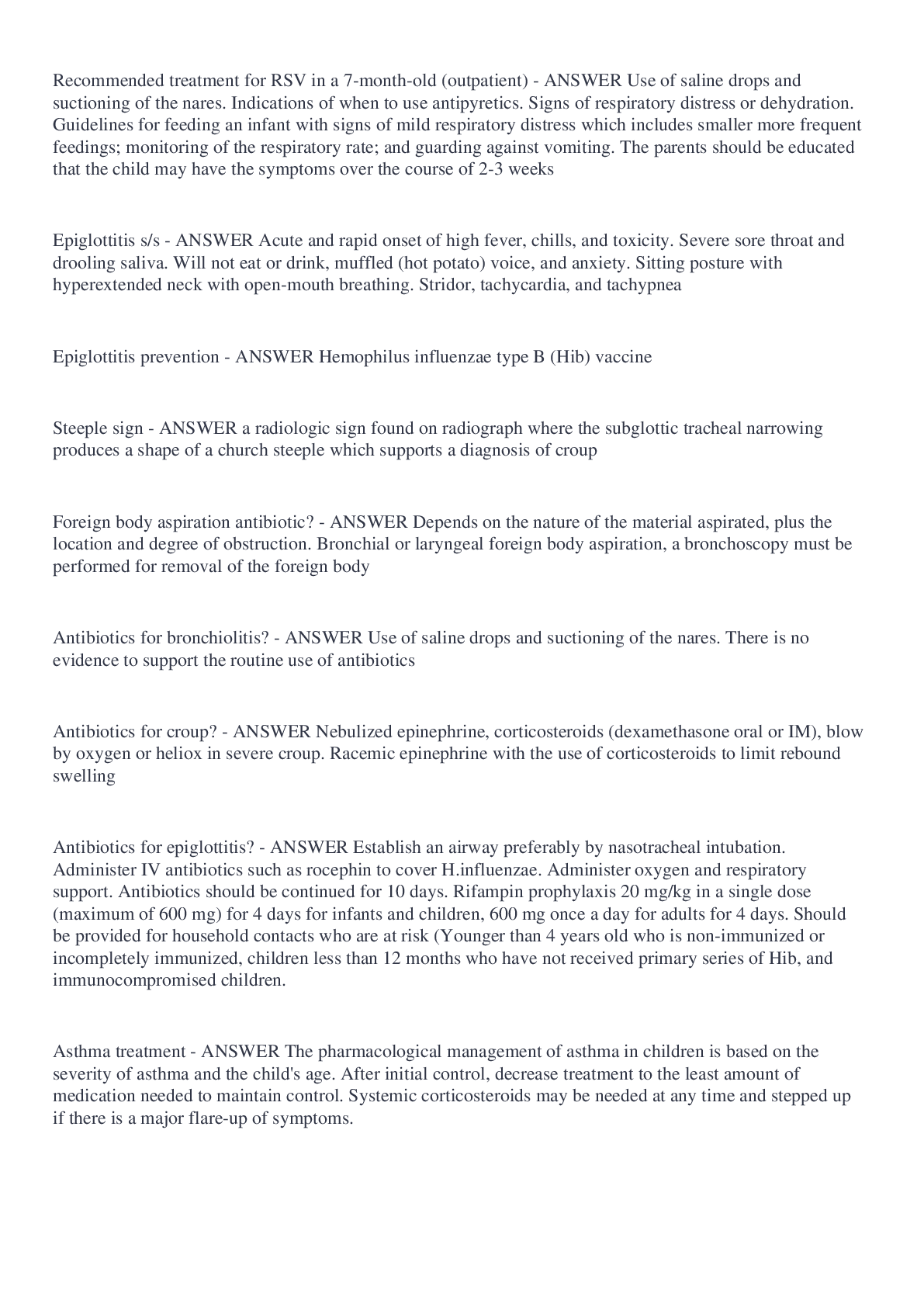
Buy this document to get the full access instantly
Instant Download Access after purchase
Buy NowInstant download
We Accept:

Reviews( 0 )
$7.00
Can't find what you want? Try our AI powered Search
Document information
Connected school, study & course
About the document
Uploaded On
Jul 02, 2022
Number of pages
31
Written in
Additional information
This document has been written for:
Uploaded
Jul 02, 2022
Downloads
0
Views
99

